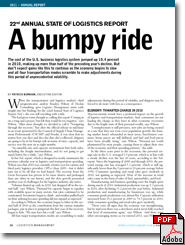2011 State of Logistics: Truckload
Tight capacity, more regulation, major concerns
Latest Material Handling News
The truckload (TL) sector, which supplies some 95 percent of capacity in the $403 billion for-hire intercity trucking industry, is enjoying a renaissance after three years of financial doldrums.
Profitability is up at the major truckload carriers. When analysts consider top TL carriers among the publicly held operations, names like Swift Transportation, Werner Enterprises, U.S. Xpress, J.B. Hunt, Knight Transportation, and Celadon Group often top their recommendations.
“The overall health of the truckload sector has improved year over year,” says Mark Rourke, president of truckload services for privately held Schneider National. “We’re continuing to expand our regional truckload business footprint as well as bring new transportation solutions to the marketplace.”
As the latest data shows, the TL carriers have enjoyed a higher weighted-average operating margin for the most recent quarters than their colleagues in the less-than-truckload sector. Overall, TL carriers have enjoyed a 4.5 percent average increase in margins in the first quarter of 2011, compared with a 2.3 percent decline among LTL carriers surveyed by SJ Consulting, a leading trucking analyst firm.
|
|
|
|
Visit the 2011 Quest for Quatlity Winners NATIONAL LTL | REGIONAL LTL | TRUCKLOAD | RAIL |
 home page |
|
|
|
“Why is that? They all use the same trucks. They all pay the same for fuel. They all use the same drivers,” remarks Satish Jindel, principal of the firm. The answer lies in the nimbleness of the non-union TL carriers. They’re able to shed capacity faster than LTL carriers, which often have complex hub-and-spoke terminal networks requiring significantly more overhead than TL carriers, which go point-to-point with their loads.
But even with those inherent advantages, many TL carriers are concerned about possible threats to capacity and costs of doing business.
An increase in container ship transloading also could affect domestic capacity, according to some intermodal experts and analysts. A global container shortage is causing some ocean carriers to transload an increasing percentage of their shipments at the ports of Long Beach and Los Angeles.
This, in turn, is causing a spike in long-haul, over-the-road freight demand for TL carriers out of Southern California. This would in turn put further pressure on capacity, which is excellent for major players in the TL market such as Hunt, Swift, and Celadon, but could have an adverse effect on overall TL capacity, executives say privately.
Then there’s the unclear regulatory environment for trucking. The Obama administration, through its Federal Motor Carrier Safety Administration, is proposing what could be a double whammy through stricter enforcement of driver standards and a potential reduction of driving hours for those drivers who do survive the tougher government scrutiny.
The government’s Compliance, Safety, Accountability (CSA) program could disqualify as many as 150,000 drivers. Potentially, a one-hour reduction in driving limits could exacerbate capacity. Until that rule is proposed later this year, the entire TL sector is on pins and needles.
“Regulations continue to provide uncertainty for carriers and shippers alike,” Schneider’s Rourke says. “The effects of CSA on driver capacity are already being felt.”

Article Topics
Features News & Resources
Latest in Materials Handling
Vehicle-mounted computers: Beyond rugged New packaging idea for the cold chain Autonomous mobile robots (AMRs) offer modern solution to challenges of traditional farming Hyster-Yale Group provides students with real-world AI experience in 2024 Kellogg Design Challenge KION Group’s board extends CEO Rob Smith’s contract by five years UniCarriers Forklift joins Quality Equipment in opening celebration of new location Largest Automate on record opens in Chicago on Monday May 6th More Materials HandlingSubscribe to Materials Handling Magazine

Find out what the world's most innovative companies are doing to improve productivity in their plants and distribution centers.
Start your FREE subscription today.
April 2024 Modern Materials Handling

Latest Resources











